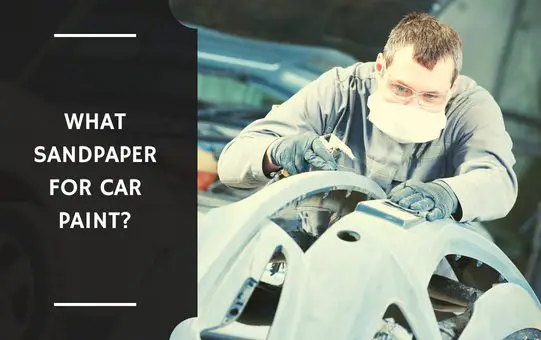When it comes to sanding car paint, choosing the right type of sandpaper is essential. The wrong grit or material can damage the paint or lead to an uneven finish.
What Sandpaper for Car Paint?
Sandpaper for car paint can be any sandpaper grade that is appropriate for the paint job. Generally, the coarser the sandpaper, the rougher the surface will be, making it better for removing paint.
In this article, we’ll explore the different types of sandpaper available for car paint and how to choose the right one for your project.
See Also: What Grit Sandpaper for Wood?
What Sandpaper for Car Paint? – Guide
Sandpaper is a type of abrasive paper that features an abrasive material, such as aluminum oxide, silicon carbide, or garnet, on a flexible backing.
It’s used for smoothing surfaces, removing paint, and preparing surfaces for painting or refinishing.
Sandpaper is available in a range of grit sizes, which determine how rough or fine the abrasive material is.
Lower grits are coarser and better suited for rougher surfaces or heavier-duty work, while higher grits are finer and better suited for smoothing and finishing.
Understanding Grit Sizes
The grit size of sandpaper is indicated by a number, which typically ranges from 40 to 2000. Lower numbers indicate coarser grits, while higher numbers indicate finer grits.
The most commonly used grit sizes for sanding car paint are 400, 600, 800, and 1000.
Coarser grits such as 320 or 240 should be used with caution for heavier-duty work, as they can quickly remove too much paint and damage the surface.
When sanding car paint, it’s important to start with a coarser grit to remove any imperfections or roughness, and then gradually move to a finer grit for smoothing and polishing.

Dura-Gold Premium Sandpaper For Car Paint
Transform your sanding game with Dura-Gold Premium 6″ Gold PSA Sanding Discs.
With a variety of grit sizes and self-adhesive sticky back design, achieve a smooth finish on car paint, woodworking, and metal projects. 50 total discs included.
Types of Sandpaper for Car Paint
There are several types of sandpaper available for car paint, each with its own benefits and drawbacks.
Wet/Dry Sandpaper

Wet/dry sandpaper can be used for both wet and dry sanding. It’s typically made from silicone carbide and is more durable than other types of sandpaper.
Wet sanding with wet/dry sandpaper can help to reduce dust and heat buildup, resulting in a smoother finish.
However, wet sanding can be messy and requires a water source and a bit of skill to get right.
Aluminum Oxide Sandpaper

Aluminum oxide sandpaper is a popular choice for sanding car paint. It’s durable and can be used for both wet and dry sanding.
It’s also relatively affordable compared to other types of sandpaper. However, it can quickly become clogged with paint, reducing its effectiveness.
Silicon Carbide Sandpaper

Silicon carbide sandpaper is harder and more durable than aluminum oxide sandpaper. It’s typically used for heavy-duty sandings, such as removing rust or deep scratches.
It can be used for wet or dry sanding but is more expensive than aluminum oxide sandpaper.
Garnet Sandpaper

Garnet sandpaper is a natural abrasive material that’s less durable than silicon carbide or aluminum oxide sandpaper.
It’s best suited for light sanding and finishing work and can be used for both wet and dry sanding. However, it can quickly wear down and become less effective.

How to Choose the Right Sandpaper for Car Paint?
Choosing the right sandpaper for car paint can depend on several factors, including the condition of the paint, the desired finish, and personal preference.
Here are some tips for choosing the right sandpaper for your project:
Consider the condition of the paint
If the paint is in good condition and only requires light sanding, finer grit sandpaper, such as 800 or 1000, may be suitable.
If the paint has imperfections, scratches, or rust, a coarser grit, such as 400 or 600, may be necessary to remove these imperfections before moving on to a finer grit.
Determine the desired finish
If a smooth, polished finish is desired, finer grit sandpaper should be used for the final sanding stages.
If a more textured or matte finish is desired, coarser grit sandpaper may be appropriate.
Consider the type of paint
Different types of paint may require different types of sandpaper. For example, harder paints may require a harder abrasive material, such as silicon carbide, while softer paints may be better suited to a softer abrasive material, such as garnet.
Practice on a small area
Before sanding the entire car, it’s a good idea to practice on a small, inconspicuous area to test the sandpaper and technique. This can help prevent accidental damage or mistakes.
Use the right technique
Proper technique is essential when sanding car paint. Sand in a circular motion, using light to moderate pressure, and be careful not to sand too aggressively or in one spot for too long.
Keep the sandpaper lubricated if wet sanding and be sure to use a sanding block or pad for even pressure.
Conclusion
Clearly, the best sandpaper for car paint depends on the condition of the paint and the desired outcome.
It’s important to do research, experiment, and consult a professional to figure out which sandpaper is right for the job and can help you get the perfect finish.
No matter what kind of sandpaper you choose, with some time, effort, and patience you can achieve a beautiful and lasting result.
I hope this blog post is helpful for you in understanding what sandpaper for car paint.
Read Also: Why Are Cats Tongues Like Sandpaper?




